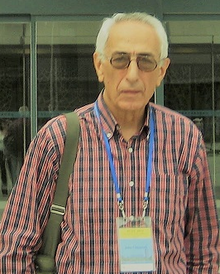후안셔 차렐리
Juansher Chkareuli후안셔 (존) 차르룰리 | |
|---|---|
 | |
| 태어난 | 1940년 1월 13일 ) |
| 모교 | 트빌리시 주립 대학교 |
| 로 알려져 있다. | 가족 대칭, 확장된 대통합 이론, 비상 게이지 및 중력 이론 |
| 과학 경력 | |
| 필드 | 이론 입자 물리학 |
| 기관 | 트빌리시 주립대학 안드로니카쉬빌리 물리연구소 일리아 주립대학교 이론물리연구소 |
| 박사학위 자문위원 | 세르게이 마티얀 빅터 오기에베츠키 |
| 박사과정 학생 | 조르기 드발리 |
Juansher Levan Chkareuli (Georgian: ჯუანშერ ჩქარეული; born 1940, Tbilisi) is a Georgian theoretical physicist working in particle physics, Head of Particle Physics Department at Andronikashvili Institute of Physics of Tbilisi State University and Professor at Institute of Theoretical Physics of Ilia State University in Tbilisi.[1][2]
학력
트빌리시 주립대학과 레베데프 물리연구소(모스코우)에서 공부했으며, 1965년 이론물리학에서 MSc를 받았다.1970년 박사학위를, 1985년 안드로니카슈빌리 물리학연구소(트빌리시)와 공동핵연구소(러시아)에서 박사학위를 마쳤다.
그 후 안드로니카쉬빌리 물리학연구소 수석연구위원(1985–현재), 트빌리시 주립대학 이론물리학과 교수(1986-1990), 일리아 주립대학 이론물리학과 교수(2006–현재)로 일했다.
1991~2012년에는 제네바에 있는 유럽원자력연구기구(CERN), 뮌헨에 있는 국제이론물리연구소(ICTP), 뮌헨에 있는 맥스플랑크연구소, 멜버른 주립대 글래스고우 대학 등 고에너지물리학 분야의 많은 선도적인 센터에서 방문연구교수를 역임하기도 했다.베이징에 있는 고에너지 물리학의 그것.
J.L. Chkareuli는 주로 가족 대칭, 확장된 대통합 이론, 그리고 신생 게이지와 중력 이론에 관한 그의 연구로 알려져 있다.이러한 개발에는 다음이 포함된다.그 키랄의 가족은 대칭 SU(3)의 quark-lepton generations[3]에 대한 소개고 맛을 쿼크와 경입자 혼합 구성에 관한 소설은 초대칭성 SU(8) 대통일 이론은 게이지 계층 문제와 맛의 통일을 위해 동시 해결책을 제안하는 것에 virtualeventvariable가상 사건 변수 장치가 행방 불명이 되는[9][10] 새로운 주류[4][5][6][7][8].선형 시그마 모델들을 위하여급발진 게이지와 중력 이론은 국소 내부 및 스페이스타임 대칭의 역동적인 생성을 유도하며, 게이지장과 그라비톤을 무중량 벡터/텐서 골드스톤 보손으로 사용한다.[11][12][13][14][15]
그는 또한 대통령은 그루지야의 물리 학회(1993–99)의 높은 에너지 물리학-연간 조지아 겨울 학교에 입자 물리학과 우주론(Bakuriani, 조지아, 1970–1993)[16]에 몇가지 주목할 만한 회의와 워크샵의 주최자이고 co-organizer을 하고 한 전 Sovi에서 가장 인기 있는 과학적 회의의 알려져 있다.(Union; 국제 세미나 "표준 모델 및 그 이상"(Tbilisi, 1996년)[17]국제 회의 "저차원 물리 및 게이지 원리"(Yerevan & Tbilisi, 2011) 및 기타.
명예 및 상
로열 소사이어티 펠로우십(1993-94), 로열 소사이어티 공동 프로젝트 보조금(1999-2000), 조지아-미국 양자 보조금(2003-2005)미국물리학회 회원(1993년), 물리학연구소 회원(영국, 2000년)『과학과 공학에서 누가 누구인가 »』(2008), 뉴욕 주 마키우스 후즈 후즈 후즈 후즈, 』2000 우수 과학자 2008/2009 »(2010), 케임브리지 주 국제 전기 센터(International Livorical Center, Centre) 등 인명 사전 목록에 수록되어 있다.
참조
- ^ http://www.worldcat.org/title/juansher-john-levan-chkareuli/oclc/4780133409&referer=brief_results#reviews.
- ^ https://www.researchgate.net/profile/JL_Chkareuli.
- ^ Chkareuli, J. L. (December 1980). "Quark-lepton families: from SU(5) to SU(8) symmetry" (PDF). Soviet Journal of Experimental and Theoretical Physics Letters. 32 (11): 671–674. Bibcode:1980JETPL..32..671C. ISSN 0021-3640. DESY-L-TRANS-253.
- ^ Berezhiani, Z.G.; Chkareuli, J.L. (April 1983). "Quark-Lepton Families in a Model with SU(5)⊗SU(3) Symmetry". Sov. J. Nucl. Phys. 37 (4): 618.
- ^ Berezhiani, Z.G. (September 1983). "The weak mixing angles in gauge models with horizontal symmetry — A new approach to quark and lepton masses". Physics Letters B. 129 (1–2): 99–102. Bibcode:1983PhLB..129...99B. doi:10.1016/0370-2693(83)90737-2.
- ^ Khlopov, Maxim Yu (1999). Cosmoparticle Physics. Singapore: World Scientific. p. 577. ISBN 9810231881.
- ^ King, S.F.; Ross, G.G. (November 2001). "Fermion masses and mixing angles from SU(3) family symmetry". Physics Letters B. 520 (3–4): 243–253. arXiv:hep-ph/0108112. Bibcode:2001PhLB..520..243K. doi:10.1016/S0370-2693(01)01139-X. S2CID 6510221.

- ^ Appelquist, Thomas; Bai, Yang; Piai, Maurizio (August 2005). "Breaking discrete symmetries in broken gauge theories". Physical Review D. 72 (3): 036005. arXiv:hep-ph/0506137. Bibcode:2005PhRvD..72c6005A. doi:10.1103/PhysRevD.72.036005. S2CID 119330778.
- ^ Chkareuli, J.L.; Gogoladze, I.G.; Kobakhidze, A.B. (February 1998). "SU(N) supersymmetric grand unified theories: Natural projection to low-energies". Physical Review Letters. 80 (5): 912–915. Bibcode:1998PhRvL..80..912C. doi:10.1103/PhysRevLett.80.912.
- ^ J.L. Chkareuli,"SU(N)SUSY GUTS 문자열의 잔여물과:최소의 SU(5)와 그 이후", 이 강연은 29일 국제 회의에 참석해 고에너지 물리학(ICHEP '98), 밴쿠버, 23–29 7월 1998년 지정되 Chkareuli, J.L.(1999년), ICHEP 98의 회보, 싱가포르:.세계 과학,를 대신하여 서명함. 1669–1673, arXiv:hep-ph/9809464, doi:10.1142/9789812818096, 아이 에스비엔 9810237723.
- ^ Chkareuli, J.L.; Froggatt, C.D.; Nielsen, H.B. (August 2001). "Lorentz invariance and origin of symmetries". Physical Review Letters. 87 (6): 091601. arXiv:hep-ph/0106036. Bibcode:2001PhRvL..87i1601C. doi:10.1103/PhysRevLett.87.091601. PMID 11531559. S2CID 18464992.
- ^ Visser, Matt (July 2009). "Lorentz symmetry as a quantum field theory regulator". Physical Review D. 80 (3–4): 025011. arXiv:0902.0590. Bibcode:2009PhRvD..80b5011V. doi:10.1103/PhysRevD.80.025011. S2CID 2585130.
- ^ Sindoni, Lorenzo (May 2012). "Emergent models for gravity: An overview of microscopic models". SIGMA. 8 (1): 027. arXiv:1110.0686. Bibcode:2012SIGMA...8..027S. doi:10.3842/SIGMA.2012.027. S2CID 16682347.
- ^ Sundermeyer, Kurt (2014). Symmetries in fundamental physics. Cham, Switzerland: Springer. p. 763. doi:10.1007/978-94-007-7642-5. ISBN 9789400776418.
- ^ Chkareuli, J.L. (April 2017). "On the origin of Poincare gauge gravity" (PDF). Physics Letters B. 769 (3–4): 377–384. Bibcode:2017PhLB..769..377C. doi:10.1016/j.physletb.2017.04.012.
- ^ "Inspire".
- ^ "Inspire".
- ^ http://inspirehep.net/record/1220831, http://crd.yerphi.am/Conferences/lowdim2011/home


